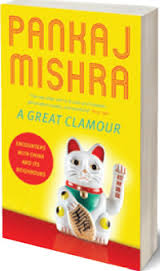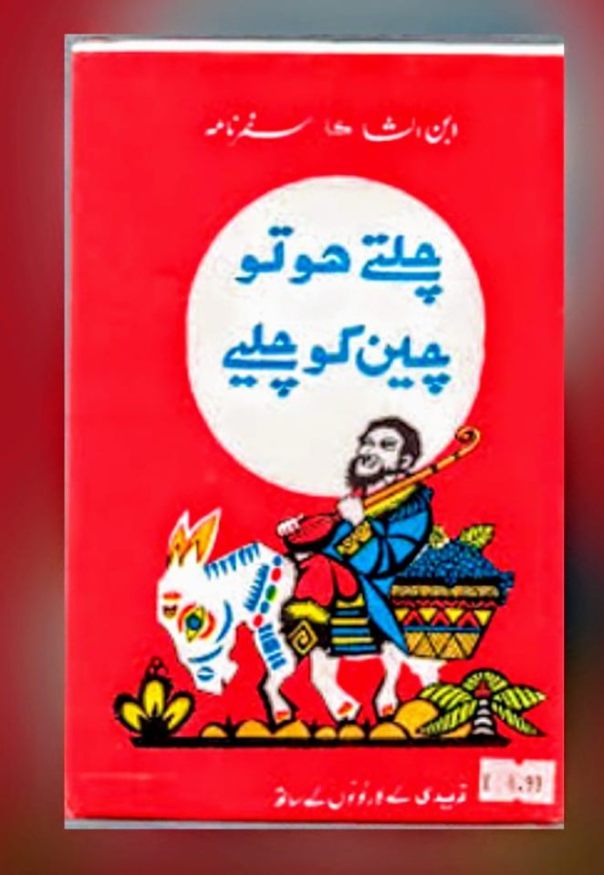Pankaj Mishra’s new book ‘A Great Cla mour’ should definitely not judged by its ugly cover. It is a starting point of a new discourse where questions like ‘what does it mean to outgrow growth itself’ with ageing still patriotic Japan as an example. Japan is definitely not the center of book. The story of Japan arrives in the last chapter.
mour’ should definitely not judged by its ugly cover. It is a starting point of a new discourse where questions like ‘what does it mean to outgrow growth itself’ with ageing still patriotic Japan as an example. Japan is definitely not the center of book. The story of Japan arrives in the last chapter.
It is China and the reflections of author on Chinese culture, state, governance and command area of influence which are center to the book. The nationality of the author becomes very visible when we see him drawing parallels and commenting on Indian polity in comparison to Asian giant.
China is deeply embedded in our imaginations and reality. Chinese food (which I am sure, has no relationship of whatsoever kind with the cuisine across the border) is a charming delight, Chinese electronics flood our households and market, we share a long border with the Chinese state, our sympathy with Tibetans to challenge Chinese hegemony, our politicians regularly quote the examples of exemplary growth of China- still we know very less about it. In general we are very suspicious of our neighbor but the great Indian middle class romanticizes the authoritarian government there. They see that model as the best way to get rid of all the problems we face. Indians desire strong leadership like China. But the fact is very few talk are aware about the deep inequalities in Chinese society, corruption, an issue which usurped the Congress government in Delhi and sent tremors across the Indian political class, is a common trait of governance, poverty is not yet managed.
Mishra points out that China is neither communist nor fairly liberal. The market is open and polity is closed. China chose authoritarian government and India preferred Westminster democracy. Both are still to achieve availability of basic services for their large poor population, still ‘For many Indians what China proved was how an authoritarian system helped rather than hindered growth…’ Our hungry eyes are looking towards China for adopting its model of strong central governance. This has been well represented in the book. Indian middle class is looking forward to see Gujarati fascist as a Prime Minister who is ‘Indian exponent of capitalism with Chinese characteristics’ has been reiterated by Mishra.
When we are talking about China how can we miss Tibet, Mishra visited Lhasa by using the celebrated Chinese railway and wrote like all other journalists about the iron handedness of Chinese state, economic and increasing cultural poverty of Tibetans who still love Dalai Lama but have to hide their allegiances to the Holy leader in order to survive. He very briefly mentions about the struggle in Xinjiang (Uighur majority province asking for autonomy to self rule). Uighurs lack charismatic leader like Dalai Lama as a result their cause is under represented. Mishra didn’t do with justice with them while talking about China.
From mainland China Mishra went to Hon Kong. Hon Kong is the citadel of capitalism with money making the only desire and that’s the best summary.
Next station in his journey is Ulan Bator.
Indians know Mongolia through fierce Mongolian warlord Genghis Khan. That is the benchmark of our knowledge about fairly democratic but corrupt republic trapped between Russia & China. He adds to it and talks about the new ironic nationalism in Mongolia where Genghis Khan becomes the model of modern day governance. And he is correct in stating that ‘Certainly, murders committed by Stalin and Hitler in the twentieth century have made Genghis Khan appear as a moderate’, we can surely add the adventures of Islamists in Syria & Mullahs in Pakistan, Iran, Hindutva rioters and massacres in Vietnam, Sri Lanka and Cambodia in the list.
Next Station Taipei; Taiwan is liberal & democratic still struggling to carve its niche in international affairs. It is yet to be represented in United Nations. Most books and movies banned in China are released in Taiwan. There is growing identity reclamation where citizens prefer to call themselves Taiwanese than Chinese which has been talked in length.
After Taipei, Kaula Lumpur is there in his itinerary. Better was if Mishra ji missed Kuala Lumpur. There are partial observations and conclusion which lead nowhere except he restated Malaysia tourism slogan ‘Malaysia truly Asia’.
He seems to be fairly equipped with pool of information about Indonesia. Jakarta is the next station. Indonesia has experimented with both dictatorship and decentralized democratic governance. One came after the other and is laid on the foundation of illegitimate favors, vote bank and greed to grab resources. Not very different from India it seems. There is growing Islamic fundamentalism where Indonesian Muslims are more aware about the condition of Palestinians in Gaza than their own home grown inequality. In the grim crisis there is still a hope- Jakarta’s governor Widodo, better known as Jokowi is a popular leader. According to Mishra in his seven years of tenure as a Mayor Widodo ‘turned the city into an instructive example of what he calls bottom up governance,’ ‘he favored small food cart owners over global convenience store chains and shopping malls. He peaceably relocated unregulated street vendors to a new marketplace, enhanced access to public health services and championed small and medium size industries against local and foreign government.’ The tasks which the state governments in India are unable to undertake, and left to Union Government, was executed by a Mayor of a city. Much hyped Bali Hindu culture doesn’t even find a reference in the book which makes the picture incomplete.
After Jakarta it is Tokyo –Japan. Mishra picks up the narrative where he left in his last book ‘From the Ruins of Empire.’ He poses a pertinent question- what after being developed? Japan is wealthy still every fifteen minutes there is a suicide, child sexual abuse cases are increasing and society is moving towards renewed conservative nationalism. What do we do after we become rich?
Mishra like in his previous books draw a reasonably long list of books worth reading to gain enlightenment. It is definitely a worth reading & quoting book with a speedy narrative especially in the times when an authoritarian government is desired to resolve our problems. It can be used as a textbook for foreign diplomats and politicians to draft ‘looking east’ foreign policy, ah may be over-appreciating the book!

